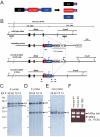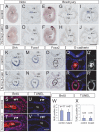Wnt signaling maintains the notochord fate for progenitor cells and supports the posterior extension of the notochord
- PMID: 19720144
- PMCID: PMC2757446
- DOI: 10.1016/j.mod.2009.08.003
Wnt signaling maintains the notochord fate for progenitor cells and supports the posterior extension of the notochord
Abstract
The notochord develops from notochord progenitor cells (NPCs) and functions as a major signaling center to regulate trunk and tail development. NPCs are initially specified in the node by Wnt and Nodal signals at the gastrula stage. However, the underlying mechanism that maintains the NPCs throughout embryogenesis to contribute to the posterior extension of the notochord remains unclear. Here, we demonstrate that Wnt signaling in the NPCs is essential for posterior extension of the notochord. Genetic labeling revealed that the Noto-expressing cells in the ventral node contribute the NPCs that reside in the tail bud. Robust Wnt signaling in the NPCs was observed during posterior notochord extension. Genetic attenuation of the Wnt signal via notochord-specific beta-catenin gene ablation resulted in posterior truncation of the notochord. In the NPCs of such mutant embryos, the expression of notochord-specific genes was down-regulated, and an endodermal marker, E-cadherin, was observed. No significant alteration of cell proliferation or apoptosis of the NPCs was detected. Taken together, our data indicate that the NPCs are derived from Noto-positive node cells, and are not fully committed to a notochordal fate. Sustained Wnt signaling is required to maintain the NPCs' notochordal fate.
Figures







Similar articles
-
Canonical Wnt signaling in the notochordal cell is upregulated in early intervertebral disk degeneration.J Orthop Res. 2012 Jun;30(6):950-7. doi: 10.1002/jor.22000. Epub 2011 Nov 14. J Orthop Res. 2012. PMID: 22083942
-
Tcf3 represses Wnt-β-catenin signaling and maintains neural stem cell population during neocortical development.PLoS One. 2014 May 15;9(5):e94408. doi: 10.1371/journal.pone.0094408. eCollection 2014. PLoS One. 2014. PMID: 24832538 Free PMC article.
-
Electric signals regulate directional migration of ventral midbrain derived dopaminergic neural progenitor cells via Wnt/GSK3β signaling.Exp Neurol. 2015 Jan;263:113-21. doi: 10.1016/j.expneurol.2014.09.014. Epub 2014 Sep 28. Exp Neurol. 2015. PMID: 25265211
-
Wnt some lose some: transcriptional governance of stem cells by Wnt/β-catenin signaling.Genes Dev. 2014 Jul 15;28(14):1517-32. doi: 10.1101/gad.244772.114. Genes Dev. 2014. PMID: 25030692 Free PMC article. Review.
-
Cross-talk of WNT and FGF signaling pathways at GSK3beta to regulate beta-catenin and SNAIL signaling cascades.Cancer Biol Ther. 2006 Sep;5(9):1059-64. doi: 10.4161/cbt.5.9.3151. Epub 2006 Sep 4. Cancer Biol Ther. 2006. PMID: 16940750 Review.
Cited by
-
Genome-wide identification of notochord enhancers comprising the regulatory landscape of the brachyury locus in mouse.Development. 2023 Nov 15;150(22):dev202111. doi: 10.1242/dev.202111. Epub 2023 Nov 9. Development. 2023. PMID: 37882764 Free PMC article.
-
Generation of knock-in mice that express nuclear enhanced green fluorescent protein and tamoxifen-inducible Cre recombinase in the notochord from Foxa2 and T loci.Genesis. 2013 Mar;51(3):210-8. doi: 10.1002/dvg.22376. Epub 2013 Feb 25. Genesis. 2013. PMID: 23359409 Free PMC article.
-
Convergent extension in mammalian morphogenesis.Semin Cell Dev Biol. 2020 Apr;100:199-211. doi: 10.1016/j.semcdb.2019.11.002. Epub 2019 Nov 13. Semin Cell Dev Biol. 2020. PMID: 31734039 Free PMC article. Review.
-
Notochordal cell-derived therapeutic strategies for discogenic back pain.Global Spine J. 2013 Jun;3(3):201-18. doi: 10.1055/s-0033-1350053. Epub 2013 Jul 12. Global Spine J. 2013. PMID: 24436871 Free PMC article. Review.
-
Differentiation of human induced pluripotent stem cells into nucleus pulposus-like cells.Stem Cell Res Ther. 2018 Mar 9;9(1):61. doi: 10.1186/s13287-018-0797-1. Stem Cell Res Ther. 2018. PMID: 29523190 Free PMC article.
References
-
- Abdelkhalek HB, Beckers A, Schuster-Gossler K, Pavlova MN, Burkhardt H, Lickert H, Rossant J, Reinhardt R, Schalkwyk LC, Muller I, Herrmann BG, Ceolin M, Rivera-Pomar R, Gossler A. The mouse homeobox gene Not is required for caudal notochord development and affected by the truncate mutation. Genes Dev. 2004;18:1725–36. - PMC - PubMed
-
- Agathon A, Thisse C, Thisse B. The molecular nature of the zebrafish tail organizer. Nature. 2003;424:448–52. - PubMed
-
- Ang SL, Rossant J. HNF-3 β is essential for node and notochord formation in mouse development. Cell. 1994;78:561–574. - PubMed
-
- Beck CW, Slack JM. A developmental pathway controlling outgrowth of the Xenopus tail bud. Development. 1999;126:1611–20. - PubMed
-
- Beck CW, Whitman M, Slack JM. The role of BMP signaling in outgrowth and patterning of the Xenopus tail bud. Dev Biol. 2001;238:303–14. - PubMed
Publication types
MeSH terms
Substances
Grants and funding
LinkOut - more resources
Full Text Sources
Medical
Molecular Biology Databases

